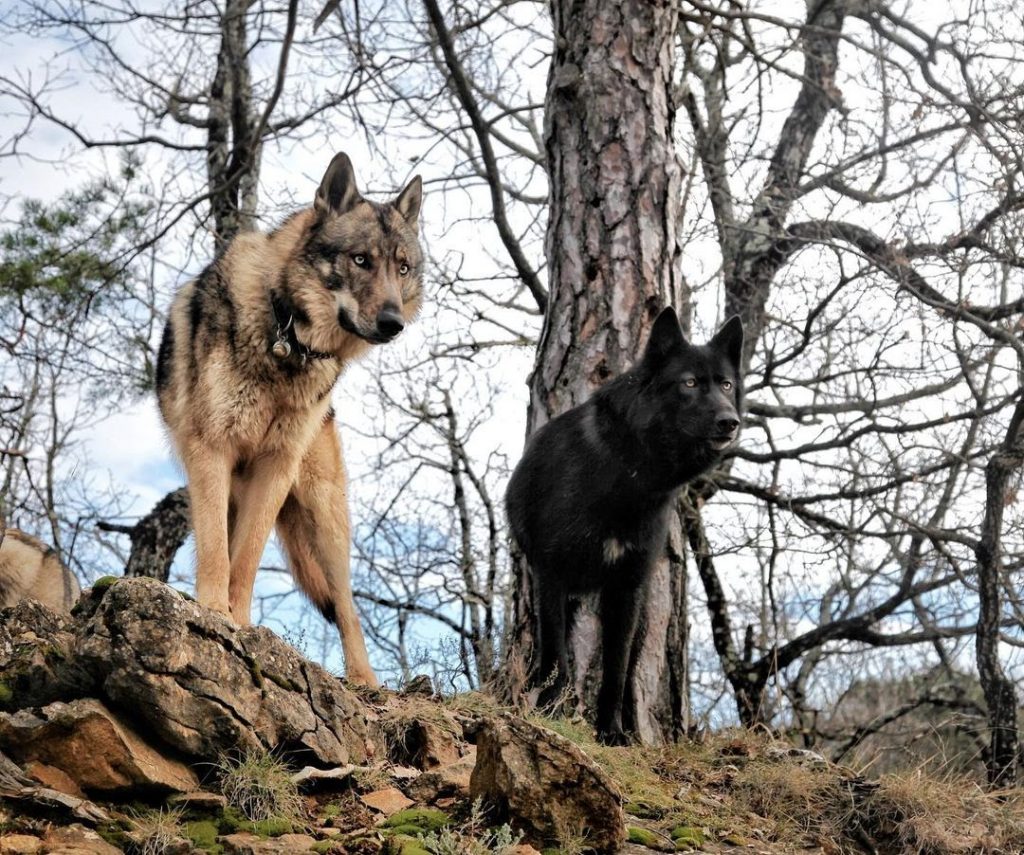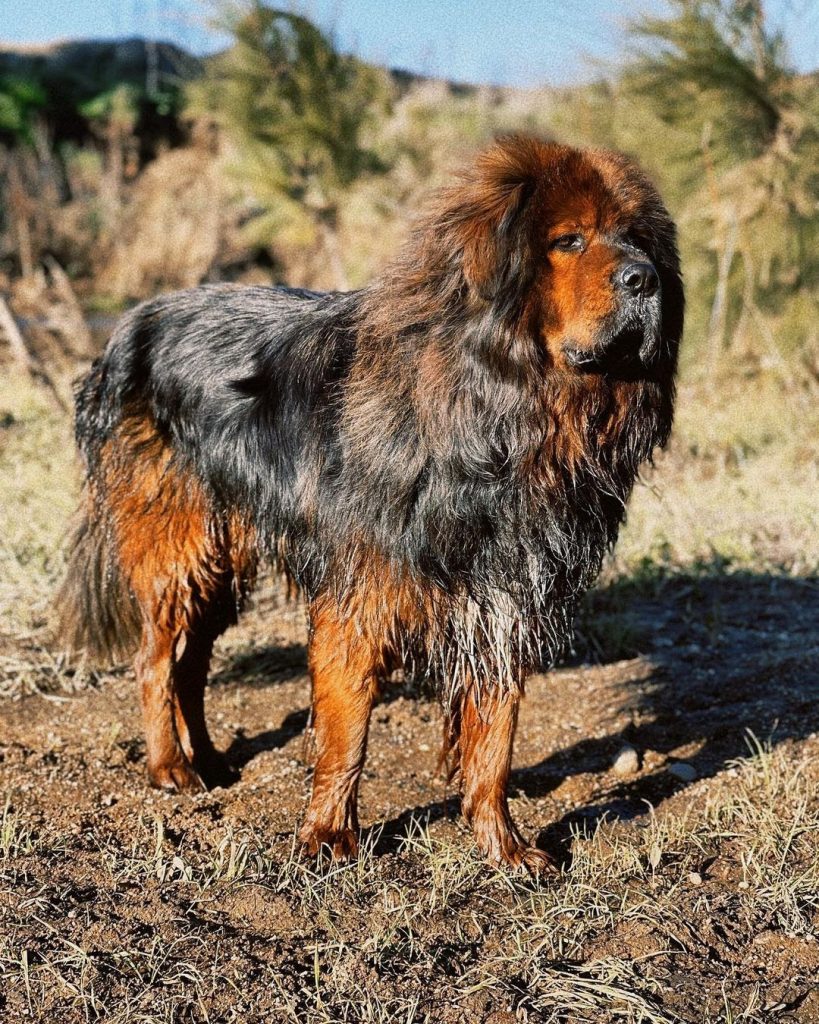Tibetan Mastiff vs Wolf: Can Your Mastiff Defend You?


The moment you encounter a wolf and you happen to have brought your Tibetan Mastiff with you, expect him to be able to defend you from the threatening presence of such a wild animal. The outcome will vary depending on how many wolves are in the pack or how many Tibetan Mastiffs are there to guarantee your safety.
Although this encounter is not very common, this can happen, especially during your camps or adventures in the forest. And, if you have a magnificent Tibetan Mastiff with you, your concern about lurking predators nearby will turn out low.
If you are a proud Tibetan Mastiff parent or have a great liking for this breed, reading this article will make you fall in love deeper with this canine, so keep reading!
Table of Contents
How to Spot a Wolf


Wolves are by far, one of the recognizable animals in the wild. They’re generally large but the place and environment often dictate how big they would get. Northern wolves are larger than those from the south, nevertheless, they have this imposing and dignified look with mesmerizing eyes that can be amber, pale yellow, and green.
A wolf’s head is large and his snout is pointy. His topcoat is coarse and the undercoat feels softer. It is long but not too long and it aids him in thriving in both colder and warmer climates.
Both ears stand erect, seemingly alert for any rustling sounds in the forests. Despite so much competition for food in the wild, this animal is commonly described as fit. He has long athletic legs and a bushy tail that goes straight out when he runs after prey.
How Big Is a Tibetan Mastiff Compared to a Wolf?


While wolves can stand tall for about 31 to 33 inches and weigh at least 60 to 140 pounds, the Tibetan Mastiff has a minimum height ranging from 24 to 26 inches and a weight of 70 to 150 pounds. The American Kennel Club (AKC) hasn’t set a maximum ideal height acknowledging the fact that this dog can surpass the marks.
However, if we just base it on their average height measurements, the wolf is considerably at an advantage. Meanwhile, the Tibetan Mastiff wins it regarding his mass.
By appearance, the Tibetan Mastiff’s extremely fluffy coat adds up more to his size. It can grow so thick and might look heavy in the eyes too! If an adult wolf is placed beside him, no doubt, the Mastiff would win the size contest.
Can a Wolf Kill a Tibetan Mastiff?
No, the Tibetan Mastiff can’t be easily killed by a wolf. On the contrary, a Tibetan Mastiff can’t kill an adult wolf. The Tibetan Mastiff is a large canine with a remarkably dense mane prominently displayed on his neck and stature so big, it can intimidate any other animals. However, this doesn’t just function as a giver of impression. Rather, this contributes to his line of defense against attacks.
A wolf that doesn’t want to be harmed or even touched can be challenging for the Tibetan Mastiff to get a grip of. The dog lacks the agility level required to catch the wild animal. Because of this, he is more suited as a defender rather than the aggressor. Cane Corsos are more appropriate in this fight due to their excellent skills in defeating wolves. You can count the Presa Canario in, too.


To further discuss the importance of the Tibetan Mastiff’s dense coat, you have to know that the wolf would have a hard time inflicting wounds against his skin since his teeth have to go through his hefty coat first- this can weaken his bite force. And, even if he did successfully penetrate, the Tibetan Mastiff has a layer of strong muscles and thick bones which can defy the force that comes from the wolf’s bite.
Do remember as well, that the Tibetan Mastiff was mainly used as a guardian of the flocks. They served as protectors who would run after predators of various sorts like bears, leopards, and wolves included. They might’ve not done a perfect job, but one thing is clear, they’re not easy to kill.
Comparing Abilities
The Tibetan Mastiff and the wolf are two unique animals that can somehow compete in several areas. To see who has the most edge when they’re both contested against each other, below are some aspects that will help you get to know them more.
Who’s Faster?
Dogs can normally run as fast as 15 to 20 km/h. Size can affect this, however, and Tibetan Mastiffs, being large dogs, might not be that fast when running. On the other hand, the wolf can dash for about 50 to 60 km/h. This is far more impressive and it is already expected considering that he’s known for his agility.
Who’s More Clever?
The Tibetan Mastiff is a highly intelligent dog who can act and decide on his own and show stubbornness during training. Meanwhile, the wolf is an independent being too. He can make decisions on his own and needs not be trained. It is quite impossible to see which of them is smarter due to how vastly different the environments they live in.
Who Can Jump Higher?
Jumping over a six-foot yard is easy peasy for the Tibetan dog. If the fence around your home is anything less than that, he can protect his family both inside and outside the territory. Of course, the wolf’s jumping skill is far from less impressive too. He can get over the other side even if the obstacle is 12 feet tall!
Who Has a Stronger Bite Force?
A range of 660 to 1,200 PSI is estimated to be the wolf’s biting capacity. The more motivation he has to fight or kill, the greater its intensity. Inversely, the Tibetan Mastiff has it a bit low for only about 500 to 550 psi. This figure, however, is above average than a dog’s bite.
Who’s More Territorial?
Both dogs are extremely territorial. The wolf highly values his land and is often not welcoming to strangers. If he has a pack or cubs to protect, he will try to ward off uninvited guests that approach his scope of territory.
The Tibetan Mastiff is also very protective. He has a strong history as a guard dog and this remains in his bloodline until now. He will protect his family, kids, puppies, as well as the home he grew to love. He doesn’t attack unfamiliar people, but rather observes and deciphers how good their intentions are.
How to Protect Your Tibetan Mastiff From Wolf Attacks
During the warmer months, we tend to head into the mountains along with our four-legged buddies. Unfortunately, this joyful trip can end up in a disaster considering how big the growing population of the wolf is.


This can be prevented from happening by taking a few precautionary steps and by understanding the nature of wolves. Being familiar with the area helps too to avoid the wolf encounter.
Some of the ways a wolf declares territory is by howling and scent-marking. Since most of us aren’t aware of this system, we can potentially put ourselves and our dogs in harm’s way.
It is illegal in most states to shoot a wolf in public land since they are protected under the Endangered Species Act, so below are what Tibetan Mastiff owners can do to reduce the possibility of a wolf attack:
- Keep your dog on a leash. If he gets loose, he could stumble across a wolf’s territory or attract their presence.
- Recognize certain signs that indicate the presence of wolves. If there have been kills or wolf dens, chances are that these wild animals are just nearby.
- If wolves are around the area, you have to kennel your Tibetan Mastiff or let him inside your home.
- Clear your yard from any food or fruits that can attract the noses of these wild animals. Properly place the lid of the garbage if it has been left open so they cannot scavenge in your place.
- Wolves can associate the appearance of a dog with humans if your Tibetan Mastiff has a bell on his collar. Oftentimes, the wild animals will ignore the canine in fear of the dog’s human companions.
Can Tibetan Mastiffs Get Along With Wolves?
Feral Tibetan Mastiffs have higher chances of getting along with wolves mostly if they’re all amenable. Factors can come into play, however, such as their socialization backgrounds, age, sex, and hunger level. If both animals randomly have an encounter, they will ignore each other.
One evidence of why the dog and wolf get along is the creation of the well-known wolf-dog. Nevertheless, this doesn’t mean that such an event will be successful at all times.
